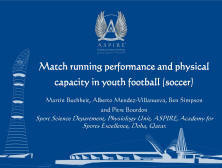Match running performance and physical capacity in youth soccer
pdf: Buchheit – Match running performance and physical capacity in youth football (soccer)
Match running performance and fitness in youth soccer.
Source
Physiology Unit, Sport Science Department, ASPIRE, Academy for Sports Excellence, Doha, Qatar. martin.buchheit@aspire.qa
Abstract
The activity profiles of highly trained young soccer players were examined in relation to age, playing position and physical capacity. Time-motion analyses (global positioning system) were performed on 77 (U13-U18; fullbacks [FB], centre-backs [CB], midfielders [MD], wide midfielders [W], second strikers [2 (nd)S] and strikers [S]) during 42 international club games. Total distance covered (TD) and very high-intensity activities (VHIA; >16.1 km·h (-1)) were computed during 186 entire player-matches. Physical capacity was assessed via field test measures (e. g., peak running speed during an incremental field test, VVam-eval). Match running performance showed an increasing trend with age ( P<0.001, partial eta-squared (η (2)): 0.20-0.45). When adjusted for age and individual playing time, match running performance was position-dependent ( P<0.001, η (2): 0.13-0.40). MD covered the greater TD; CB the lowest ( P<0.05). Distance for VHIA was lower for CB compared with all other positions ( P<0.05); W and S displayed the highest VHIA ( P<0.05). Relationships between match running performance and physical capacities were position-dependent, with poor or non-significant correlations within FB, CB, MD and W (e. g., VHIA vs. VVam-eval: R=0.06 in FB) but large associations within 2 (nd)S and S positions (e. g., VHIA vs. VVam-eval: R=0.70 in 2 (nd)S). In highly trained young soccer players, the importance of fitness level as a determinant of match running performance should be regarded as a function of playing position.




